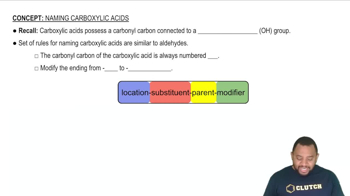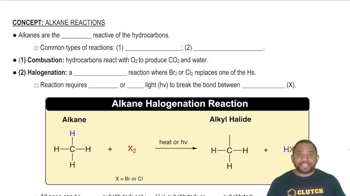Here are the essential concepts you must grasp in order to answer the question correctly.
Carboxylic Acids
Carboxylic acids are organic compounds characterized by the presence of a carboxyl group (-COOH). They are known for their acidic properties due to the ability of the carboxyl group to donate a proton (H+). This functional group is responsible for the reactivity of carboxylic acids in various chemical reactions, including esterification and decarboxylation.
Recommended video:
Rules for Naming Carboxylic Acids
Types of Reactions
Carboxylic acids can undergo several types of reactions, including esterification, where they react with alcohols to form esters, and neutralization, where they react with bases to form salts and water. Understanding these reaction types is crucial for predicting the products formed when a carboxylic acid reacts with different reagents.
Recommended video:
Common Types of Alkane Reactions
Reaction Mechanisms
The mechanisms of carboxylic acid reactions involve stepwise processes that detail how reactants transform into products. For example, in esterification, the nucleophilic attack of an alcohol on the carbonyl carbon of the carboxylic acid leads to the formation of an ester and water. Familiarity with these mechanisms helps in understanding the conditions required for the reactions and the nature of the products formed.
Recommended video:
Reaction Mechanism Overview
 Verified step by step guidance
Verified step by step guidance


